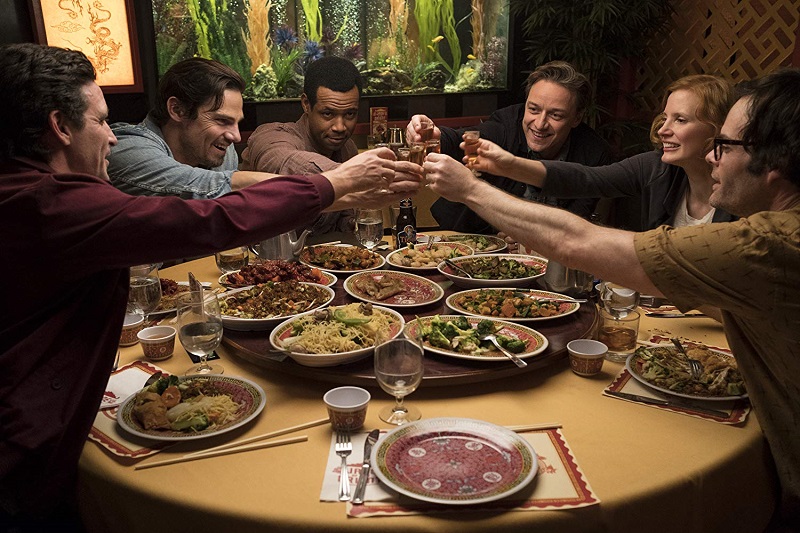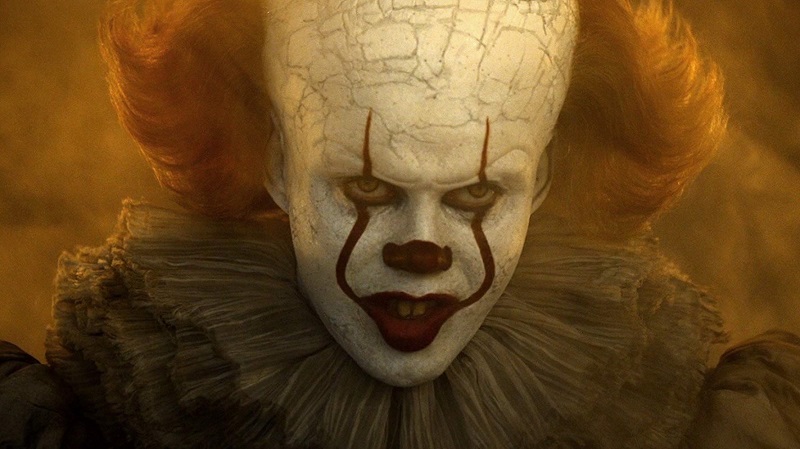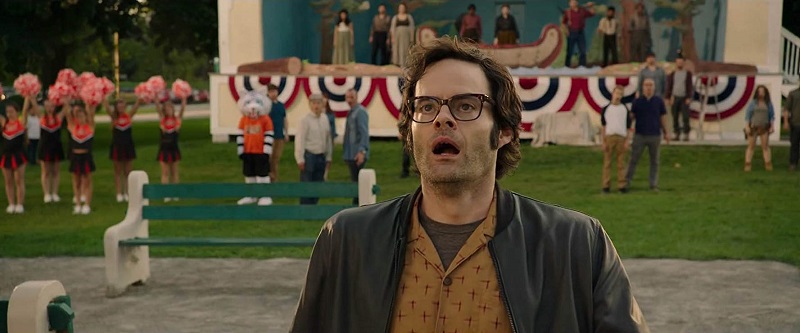The first It arrived in 2017 and was a critical and box office bonanza. The Stephen King page to screen effort vastly improved on the 1990 television miniseries, but that is not saying much. Simply as a cinematic effort, it rocked our world as it introduced us to The Losers Club and their titanic and heroic effort to beat back a psychotic supernatural clown with a penchant for killing kids.

At the close of It, The Losers Club made a blood oath to reunite in their hometown of Derry at any point in the future if It rears its frightening face again. Well, it’s been 27 years. Our Losers are all grown up … and Pennywise the Clown is back to doing what he does best. Stuck behind in Derry (the only one who remained in the nightmare causing municipality) is Mike Hanlon (Isaiah Mustafa), who works (and lives it turns out) in the town library. While the Derry Fair is going on, several folks have gone missing. We know all too well, when those Missing Person signs start appearing in town, that (expletive) clown has returned and that oath is in full effect.
Mike phones the old gang and we learn that for some reason, after that fateful blood-letting, they all essentially lost track of one another. Bill (James McAvoy) is a successful writer, who is married to an actress that is starring in an adaptation of one of his works. Ben Hanscom (Jay Ryan) is a sought-after architect who has lost quite a few pounds since we last saw “the new kid.” Richie Tozier (Bill Hader, in a stroke of casting genius) is an in-demand stand-up comic, Bev (Jessica Chastain) is married (albeit not happily) while Eddie Kaspbrak is an insurance risk evaluator—although successful, he doesn’t exactly seem thrilled with his vocation. Then there’s Stanley (Andy Bean), who is successful and has the most fascinating reaction to hearing from Mike. Then again, they all are immediately, immensely emotionally and physically altered by that caller ID that says Derry, Maine. Each looks at their hand and it (at least starts to) comes back.
Somehow, every one of those Losers discover that when they actually head down memory lane, most of their Derry experience is hazy at best, and completely vacant at the most. So, when they all get together at a Chinese restaurant in their hometown and start downing drinks and good food, a bit of those memories start to creep back and each individual gets a tad more haunted than the last. The reality of their task at hand also hangs over the group like an anvil and by the time the fortune cookies arrive, a swell of daunting anticipation has come over them like a tsunami.
The thing about a film from King’s repertoire, or any flick in the thriller/horror milieu, is that the scares and gripping suspense can only arise if the antagonist is terrifying at the minimum. Some creepiness adds layers to the experience as well and Bill Skarsgård has “It” in droves with his continuation of the terror he extoled in It. It’s hard to imagine that Skarsgård could scare us any more than he did in the 2017 film, but he digs deeper—as does every single soul in this ensemble—and delivers an iconic turn. The collective that is what Skarsgård gives us in It and It: Chapter Two firmly places Pennywise in the upper echelons of movie villains. He does so much with what King, and screenwriter Gary Dauberman, gives him on the page that merely the sight of the actor in that chilling clown makeup sends fear permeating through our bodies. That says it all, really. When a thespian delivers an explosive turn in the antagonist department that something as pedantic as a still photograph of them in character ushers in a flood of fear, you have done extraordinary work. Think Jack Nicholson’s peering face in The Shining, Darth Vader stepping through the smoke in Star Wars and that particular hockey mask worn by Jason in Halloween. These images don’t manufacture our emotive and physical response in a vacuum. It is what the actor behind the madness does with their screen time that transcends the art of cinema and pulsates fear in the film going masses.
Audiences fell in love with The Losers Club in It. Each character was expertly cast, and the young thespians tasked with portraying these pushed to their limit kids turned in performances that grabbed audiences by the lapels and never let us go, long after the credits rolled. Introducing them as adult characters put so much of the stress on whether It: Chapter 2 would have the same success on the casting director and their team. Rich Delia could not have done a better job if he tried.
Oscar nominee Chastain, you must know given her career, would knock it out of the park as the only female member of The Losers Club. After what he did in Split and Glass, McAvoy showed that there are few actors of his generation able to achieve such emotional kinship with his audience. His character of Bill has some speech issues, if you will recall from the first film. McAvoy portrays Bill as having overcome those impediments. Yet it is only when he becomes rattled that it is a tell that Bill is terrified—and thus, we should be too. Is there anything McAvoy cannot do? Heck, after tackling two-dozen parts in those M. Night Shyamalan movies, no … no there is nothing he can’t do!

Mustafa had a difficult task with Mike. He stayed behind and has lived a lonely existence for almost three decades. There could have been slivers of resentment in his characterization, but that’s not Mike. He believes that he has a job to do and the fate of Derry is firmly on his shoulders. If you recall, as a child he had some issues to grapple with due to his family’s death in a fire. Perhaps he feels that by staying behind on “Pennywise watch,” it aides his familial guilt? Whatever the actor decided with his backstory, it worked wonders because he threaded the needle that is Mike with the greatest of ease. Ryan too is a standout in the ensemble. Sure, his character dropped some pounds since his buddies last saw him, but there’s an emotional element to overeating that the actor channels in other ways with his level-headed turn as Ben.
Then, there’s Hader. It helps that his character is a stand-up and as we all know, the Saturday Night Live vet got his start in the same way. But he is charged with commanding the screen and emitting an overwhelming wave of fear, anger and even guilt with his Richie. The comic actor shows some killer dramatic chops with his performance and it could be argued that his turn makes him the film’s MVP. That could be the case, if not for the hurricane of horror unleashed by Skarsgård. In fact, don’t be surprised if a certain smaller monologue he utters when first facing those Losers runs through your head for days after the It: Chapter 2 experience. The way he states, “For 27 years, I dreamt of you. I craved you … I’ve missed you!” will ricochet through your head in the most evocative of manners.
There are issues with It: Chapter Two. One is its length. Hey, there are no issues with longer movie experiences. After all, this is from a book by King, who is notoriously prolific with his page count. There are just moments that pop up throughout that drag a bit and it allows the mind to wander. That is not something that is good for the overall horror movie endeavor. One needs a crisper, tighter movie experience to maintain that fright, recovery, character building, emotional connection culling and once again, fright pattern. When one of those elements is sluggish, the overall effort can suffer. Luckily for audiences, those drawn out beats are few and far between.

Director Andy Muschietti returns to helm the sequel to the film that firmly put him on the map. He, mostly, does a fantastic job intertwining those emotional building beats with the frightening elements. There is a much to jam into the film’s two-hours-and-fifty-minutes. There are only a few scenes that could use some tightening, but what Muschietti does with his sequel reminds us why that iconic editing phrase “kill your darlings” is so impeccably apt. Sometimes it is difficult, heck impossible, to cut anything when a storyteller feels as if each moment is imperative to the overall arc, feel and tone of the cinematic experience.
Now that all is said and done, it can be stated that Pennywise has successfully leapt off the pages and into our internal fear factory forever. What else is realized is that the real core of this film is revealed, and it is heartwarming and heartbreaking. Like so many of King’s other stories, the center of what this is about truly has nothing to do with a killer clown, just like Christine wasn’t about a killer car. It is firmly about friendship and particularly the ones made and maintained as older children. That is a rare moment within the scope of a human life that occurs when we are around the age of twelve. Friends are everything, meaning even more than our families and certainly more than scholastic endeavors. Those pals we have at that age help define us, guide us and above all else—understand us better than anyone will, probably until marriage.
After the conclusion of It: Chapter Two, look out for a wave of nostalgia that permeates your soul. King has immaculately captured the foray that is friendship as a pre-teen and early teen. The film may center on a killer clown that survived for dozens of generations and was no match for some fierce pals. But what makes It and its follow-up so resonant is its celebration of the tethered bonds of friendship and how—at that point in your life—absolutely nothing can sever those connections, not even a red balloon sporting circus freak.
Grade: B

